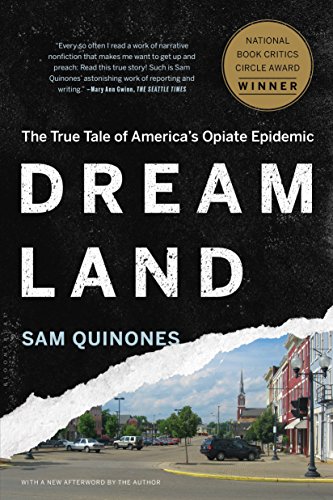Dreamland: The True Tale of America’s Opiate Epidemic by Sam Quinones.
Bloomsbury Press, New York, my edition 2016, first published 2015.
Adult nonfiction, 374 pages including index and notes.
Not leveled.
Dreamland is the far-reaching narrative of America’s unprecedented struggle with opiate addition. It looks inside doctor’s offices and pharmacutical marketing, studies villagers from Xalisco, Nayarit in Mexico, and interviews street addicts, rehabilitation workers, and more to form a comprehensive picture of how this situation developed.

This book doesn’t entirely fit my usual review criteria. After all, the author and the majority of people in it are white, although there is a substantial Mexican and Mexican-American element present. However, I decided it was close enough to my usual topics (since addicts are generally not a privileged group, even if they are white or privileged in other areas) to discuss here.
America’s opiate epidemic has been getting a lot of attention because it’s affected a lot of people that those in power don’t usually think of as potential addicts – middle class Midwestern white suburbians. Another, lesser known, oddity of the problem is that nearly all of the black tar heroin dealers in American’s smaller cities are from small towns in the tiny Mexican state of Nayarit.
Quinones interviews addicts, dealers, medical professionals, reformers, and law enforcement to provide as accurate a picture as possible of how this came to be. Most of the people he talks to are white, Mexican, or Mexican-American, although he does talk to some people of color, and he brings up the disparity between political response to this ‘epidemic’ and previous reactions such as the ‘war on drugs’.
The book has short chapters that change frequently. Despite the length and the rather depressing topic, I found this a quick read which worked well for bedtime reading (although my dreams were disturbing at times). At first, the book did seem a little choppy as there were so many disparate elements. But Quinones began to slowly weave threads together until the narrative rope was quite cohesive and clear at the end.
Quinones also offers hope and humor where possible in an otherwise bleak and depressing book. He looks not only at the treatment processes that failed (or created more addicts) but also at the methods that are succeeding, and the ways that communities are fighting back and working against addiction.
There are no photographs, but the book does have some maps, a timeline, notes, and an index. The afterword had some interesting aspects to it. Quinones was able to follow up and provide further information on a few different people or regions covered in the story. He mentions consulting with Hilary Clinton on drug policies and it seems clear that he has ideas about what might happen in the 2016 election (but didn’t).
On page 352, close to the end of the afterword, he discusses the use of trigger warnings in college classrooms as students “demanding to be protected as well from painful ideas.” Quinones seems to have misunderstood this issue, or looked only at the article cited. Common sense is a necessary part of trigger warnings, but the goal is not the avoidance of ideas that might challenge a student’s worldview.
Given that he interviewed people with PTSD and pain issues for this book, I would have expected a broader or more thoughtful perspective on this issue. However, it was a minor blip in a book that, on the whole, felt balanced and fair.
While this isn’t the sort of book I would ordinarily seek out, it’s definitely one I’d recommend. I think it’s fairly unusual to find a book this well-written and comprehensive on such a difficult topic. As you would likely guess from the topic, this book is not one I’d recommend for teens or younger. There is a great deal of heavily adult subject matter.
Great review. I really appreciated this book too, I learned so much from it and I thought the writing and organizational styles worked well for the heavy subject matter. It’s funny that you described how you read it because I did the same, a few short chapters before bed. It’s so scary and disturbing but I really want to understand the opioid epidemic and I think he did great work in exploring a big part of it.
LikeLiked by 1 person
Thank you. I suspect this will be one of my 2018 favorites – it was so readable for such a difficult topic! Hopefully others will give it a try as well. Lately I’ve found myself choosing nonfiction based on the chapter or section length because short chapters make me feel like I’m progressing even when the book is very long, and I love to read before bed.
LikeLiked by 1 person
I choose it that way sometimes too – it’s just a necessity to have the shorter structure at times, especially when I’m too mentally occupied with something else. This was definitely one of my favorites that I read last year, I wish all narrative nonfiction was this good.
LikeLiked by 1 person
This sounds like a very worthwhile and timely read and I’m glad to hear it was both well-written and well-researched. It always seems sad to me that the opiate epidemic is probably only getting so much sympathetic attention because so many of those affected are white and middle class.
LikeLiked by 1 person
It was a fascinating read – I just happened to see it on display at the library! My hope is that books like this will open people up to considering other addicts in a new light as well. This book did a great job of showing how for most of the people involved, it was circumstances far beyond their control that led to them getting addicted, and I think that’s the case for many non-white, lower-class addicts as well.
LikeLike